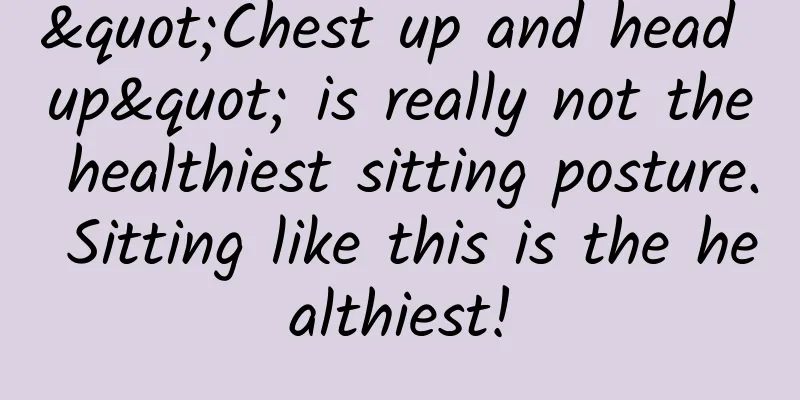"Chest up and head up" is really not the healthiest sitting posture. Sitting like this is the healthiest!

|
When we were children, we often heard our parents say to us, "Keep your head up and chest out, or you will have a hunchback later." They told us to "sit upright, keep your head up and chest out." However, keeping your head up and chest out is not the healthiest sitting posture. Copyright images in the gallery. Reprinting and using them may lead to copyright disputes. Sitting with your head up and your chest out is not the healthiest posture The physiological curvature of the spine is a combination of convex and concave. The cervical and lumbar vertebrae are physiologically lordotic, while the thoracic and sacral vertebrae are physiologically kyphotic. When we raise our heads and chests, the lordotic curvature of the cervical spine increases, and the load on the cervical spine increases. The original kyphotic curvature of the thoracic spine is artificially straightened, increasing the load on the thoracic spine. At the same time, due to the integrated nature of the spine, the lumbar spine will also compensatorily increase its lordotic angle, increasing the pressure on the lumbar intervertebral disc. This will put the entire spine in a wrong force line, causing pain and chronic diseases in the related intervertebral discs, ligaments, and muscles. Excessive chest extension will also cause our ribs to turn outward, affecting the contraction of our auxiliary muscles for breathing - the external and internal intercostal muscles, which in turn affects our respiratory function. Copyright images in the gallery. Reprinting and using them may lead to copyright disputes. What's more, "holding your head and chest out" requires more muscle participation and subjective effort to maintain, which can easily lead to muscle fatigue, and will cause back pain when you hold your head and chest out while sitting. Therefore, it is most scientific and healthy for us to choose a posture that allows the spinal curvature to be most naturally extended. How to sit more healthily? 1 Choose a Chair First, choose a suitable chair. The height of the chair should allow your feet to be placed firmly on the ground and your thighs to be parallel to the ground. The backrest of the chair should preferably have a certain inclination and curvature to fit the natural physiological curvature of the human waist and provide good support for the waist. Studies have shown that using a backrest can reduce the pressure on the spine and paraspinal muscle tissue. The inclination angle of 110°~130° can reduce the pressure on the intervertebral disc and show the least muscle activity of the spinal muscles. 2 Maintain natural spine extension When we sit, the only contact surface between us and the chair is our pelvis, which also acts as a "foundation". If the pelvis is not in the right position, our spine cannot be effectively stretched. The most correct pelvic position is to make our body weight act on the bilateral ischial tuberosities when sitting. There is a bursa at the top of the tuberosity, which secretes fluid to reduce friction and pressure between tissues. How to locate the ischial tuberosity? When we sit, we feel a bony protrusion below the buttocks, which is the ischial tuberosity. Never lie down like Ge You and put pressure on the coccyx, which will cause our pelvis to tilt backwards and the lumbar curvature to straighten. In severe cases, it will cause lumbar disc herniation. It is best to bear weight symmetrically on both sides, and do not cross your legs or lean to one side. This will easily cause the pelvis to flip sideways and cause scoliosis. The hips and back should be effectively supported by the chair. The waist should not be hanging in the air, and the back should be straight, but not too stiff. You can lean back slightly to keep the lumbar and thoracic vertebrae in a natural curvature. Slightly tighten the abdomen to keep the front and back muscles balanced, which will also make our pelvis more stable. Relax your shoulders and let them droop naturally. Do not shrug or internally rotate your shoulder joints (with your chest). Keep your neck naturally straight. Do not lower or raise your head too much. Retract your lower jaw and feel as if the top of your head is extending upward. Look straight ahead. The computer screen should be level with your line of sight and at a distance that matches the focal length of your vision. Avoid leaning forward or backward to adjust the focus when your eyes are tired. Place your arms naturally on the armrests of the chair or on the table, with your elbows bent at 90 degrees. Relax your hands and do not hold the mouse or keyboard too hard. If you need to use the mouse or keyboard for a long time, you can use a wrist pad to reduce the pressure on your wrist to avoid mouse hand. Rhythmic abdominal breathing is conducive to relaxing our neck and intercostal respiratory muscles. 3 Combining movement and stillness, exercising in a proper way Even if you maintain the healthiest sitting posture, you cannot sit still for a long time. Sitting for a long time may cause lumbar and cervical spondylosis, joint stiffness and muscle degeneration, increase the risk of heart disease and high blood pressure, and many other health-damaging diseases. It is recommended that you sit for no more than 30 minutes and then get up and move around. You can do some gymnastics, cervical spine exercises, etc. You can also stand up and walk around or step on the spot to promote blood circulation and prevent various health problems caused by sitting for a long time. References [1] BJ Gunnar Andersson, Roland Örtengren, Alf L. Nachemson, Gösta Elfström, Holger Broman, TheSittingPosture:AnElectromyographicandDiscometricStudy OrthopedicClinicsofNorthAmerica,Volume6,Issue1,1975,Pages105-120, ISSN0030-5898 [2]DonaldD.Harrison,SanghakO.Harrison,ArthurC.Croft,DeedE.Harrison,StephanJ.Troyanovich,SittingbiomechanicsPartI:ReviewoftheLiterature,JournalofManipulativeandPhysiologicalTherapeutics, Volume22,Issue9,1999,Pages594-609,ISSN0161-4754 [3] DuranAT,FrielCP,SerafiniMA,EnsariI,CheungYK,DiazKM.BreakingUpProlongedSittingtoImproveCardiometabolicRisk:Dose-ResponseAnalysiso faRandomizedCrossoverTrial.MedSciSportsExerc.2023May1;55(5):847-855.doi:10.1249/MSS.0000000000003109.Epub2023Jan12.PMID:36728338. Planning and production Author: Liu Jiaqi, Chief Therapist, Department of Rehabilitation Medicine, China-Japan Friendship Hospital Reviewer: Ji Gang, deputy chief physician of orthopedics, the First Hospital of Hebei Medical University |
<<: Little-known facts about toothbrushes: How dirty are toothbrushes?
>>: If I have paronychia, do I have to remove the nail to cure it?
Recommend
Pregnancy symptoms on the fifth day after ovulation
For women who are preparing for pregnancy, the ov...
Is it normal for girls not to have armpit hair? Is it normal for women not to have armpit hair?
Armpit hair grows under the armpits, which is a v...
What is the reason for not having menstruation for several months at the age of 14?
Many girls in puberty suffer from irregular menst...
Brown discharge after exercise
Many people have the habit of exercising. Regular...
How to choose roses? What do the roses mean?
Every Valentine's Day, roses are one of the f...
The world's number one cancer, the survival rate is very high as long as it is diagnosed and treated early!
"Popular Science of Medical Science with Cot...
Brown discharge at 8 weeks of pregnancy
Women will secrete a lot of estrogen and estrogen...
How to judge whether the flow is clean
In today's society, unmarried pregnancies are...
What is partial hydatidiform mole?
If there is excessive proliferation of placental ...
Is it normal for the baby to be one week larger according to the B-ultrasound? What is the reason for the baby to be smaller according to the B-ultrasound?
B-ultrasound is the most common test for pregnanc...
Leucorrhea is light brown and painless
If the leucorrhea appears light brown but there i...
How to deal with inflammation of episiotomy wound during normal delivery
Many women who have just given birth naturally ha...
How to sleep during pregnancy is better for the baby
In addition to lying flat on your back, there are...
What is the cause of the fetal movement?
Pregnant women should pay attention to changes in...
Pregnant woman wakes up with hand joint pain
If a pregnant woman experiences pain in her hand ...









